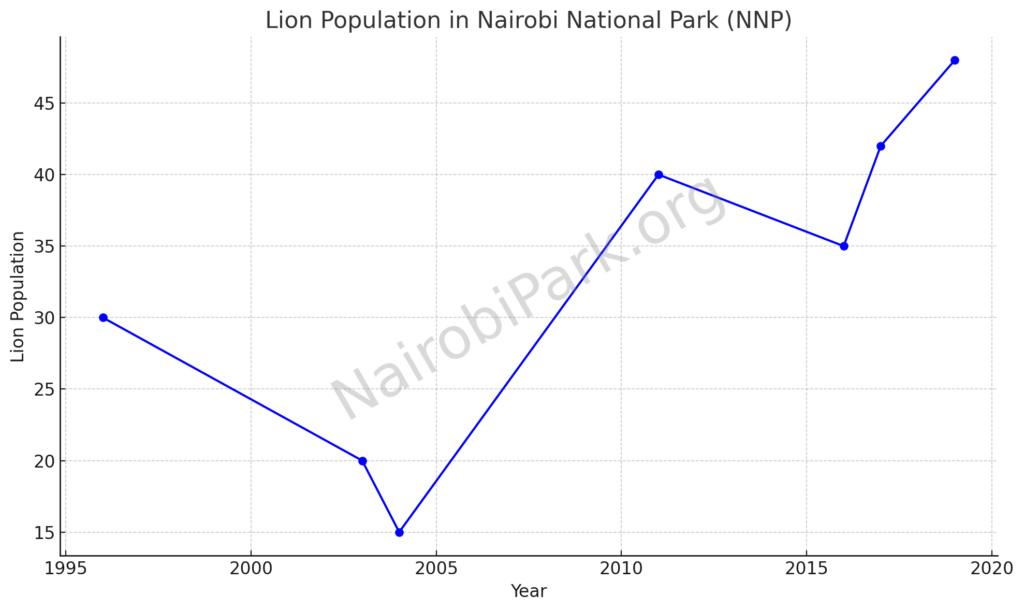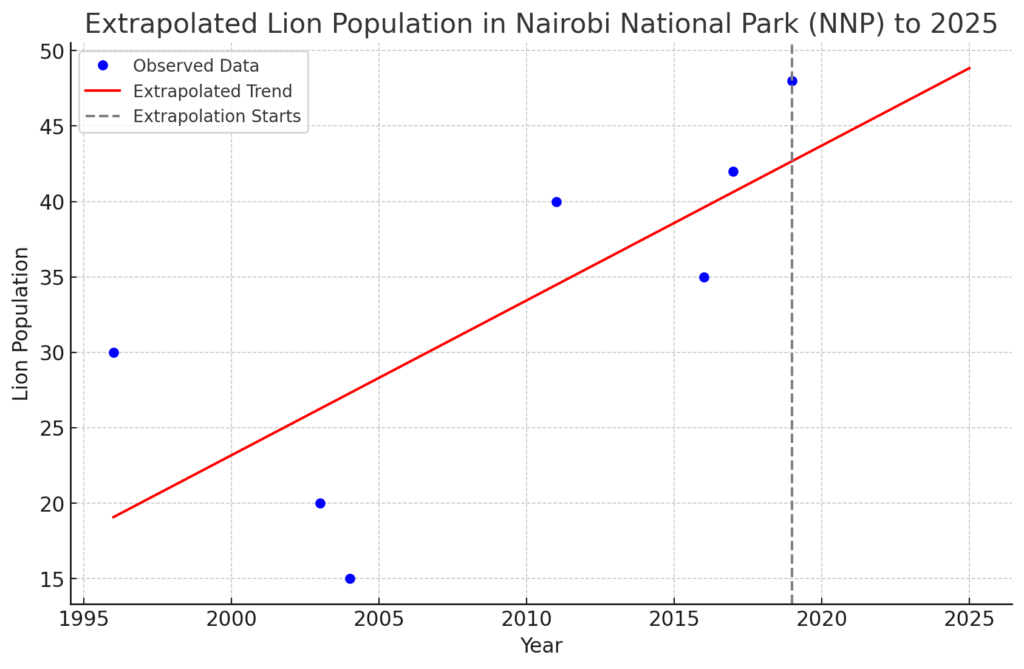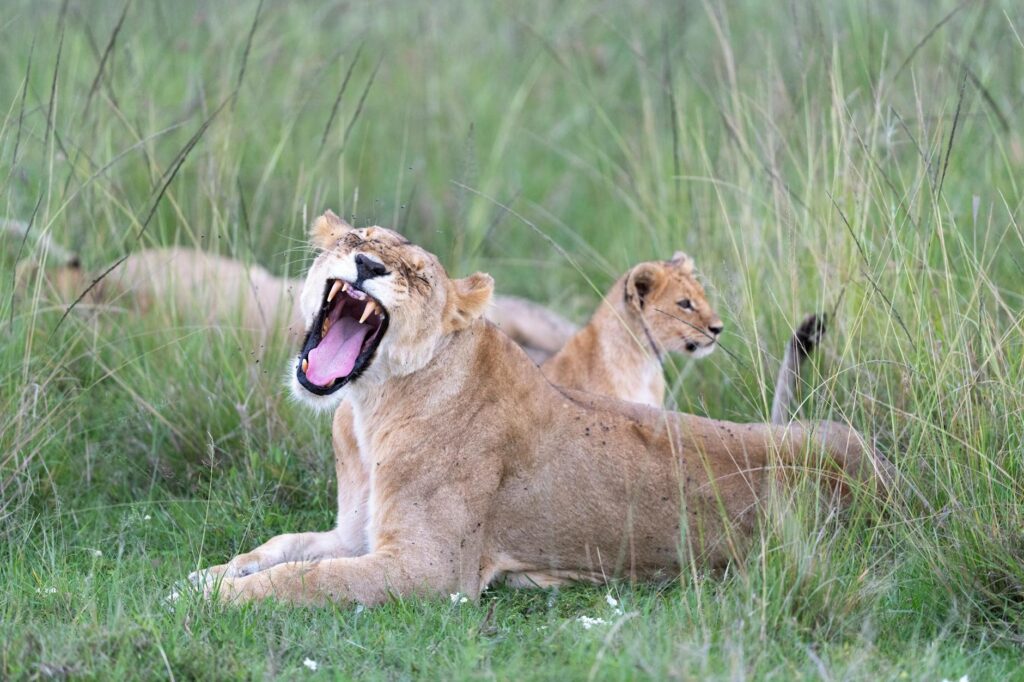Introduction
Nairobi National Park (NNP), Kenya’s iconic wildlife sanctuary located just a few kilometers from the bustling capital city, is home to a thriving population of lions. These majestic predators are not only a symbol of Kenya’s rich biodiversity but also play a critical role in maintaining the park’s ecological balance.
Lion Population Trends
The lion population in NNP has seen significant fluctuations over the years as per 2022 Study. In the late 1990s, the population hovered around 30 individuals. A decline occurred in the early 2000s, reaching as low as 15 lions by 2004. However, since 2011, the population has been on an upward trend, with numbers estimated at around 48 lions as of 2019. Extrapolations suggest that by 2025, the population could reach approximately 50 lions, largely due to immigration from adjacent areas and successful conservation efforts.

Extrapolated Lion Population in Nairobi National Park (NNP) to 2025:
Here is the extrapolated trend for the lion population in Nairobi National Park (NNP) projected up to 2025

Based on the linear trend, the lion population is estimated to reach around 50 lions by 2025 if current growth patterns continue.
Lion Carrying Capacity at Nairobi National Park (NNP)
In 2021, ecologist Daniel Muteti reported that Nairobi National Park’s (NNP) carrying capacity for lions is around 40, as per The Star Newspaper. This figure represents the maximum number of lions the park can sustainably support based on factors like prey availability, territory size, and ecological balance.
Why 40 Lions?
- Limited Space: NNP spans just 117 km², restricting territory for lions, which are highly territorial animals.
- Prey-Predator Balance: To prevent overhunting of herbivores like zebras and wildebeests.
- Resource Sustainability: Ensuring enough water, cover, and space for hunting.
Current Population Concerns
As of 2019, lion numbers were estimated at 48, and projections suggest over 50 lions by 2025, exceeding the park’s capacity. This leads to:
- Ecological Imbalance: Pressure on prey populations and risk of genetic bottlenecks
- Increased Lion Conflicts: Territorial disputes and aggression.
- Rising Human-Wildlife Conflicts: Lions leaving park boundaries, entering Nairobi suburbs.
Factors Influencing Lion Population Growth
- Immigration from Adjacent Areas: Lions have migrated into NNP due to habitat loss and increased human activities outside the park.
- Conservation Initiatives: Improved anti-poaching measures and wildlife management strategies have contributed to population stability.
- Prey Availability: The park supports a healthy prey base, including zebras, wildebeests, and buffaloes.
- Human-Wildlife Conflict Mitigation: Efforts to reduce conflicts with local communities have also helped sustain the population.
Lions Leaving the Park: A Growing Concern
In recent years, there have been cases of lions wandering out of the park and onto the streets of Nairobi. These incidents are often triggered by:
- Weak Park Fencing: Gaps in the park’s perimeter allow lions to roam freely.
- Territorial Disputes: Young males are sometimes pushed out by dominant lions, prompting them to explore beyond the park.
- Attraction to Urban Areas: Noise, lights, and the scent of livestock can draw lions towards human settlements.
Notable Incidents:
- 2016 Incident: A lion named Mohawk famously roamed Nairobi’s streets before being tragically shot due to safety concerns.
- 2019 Sightings: Several lions were spotted in Lang’ata and Mombasa Road areas, causing temporary panic among residents.
Safety Guidelines for Residents and Visitors
- Stay Calm: If you encounter a lion, do not run. Maintain eye contact, make yourself appear larger, and back away slowly.
- Report Sightings Immediately: Contact the Kenya Wildlife Service (KWS) hotline.
- Secure Livestock: Use strong enclosures to prevent attracting lions.
- Avoid Night Travel Near the Park: Lions are more active during dawn and dusk.
Conservation Challenges
- Urban Encroachment: Nairobi’s expansion continues to reduce wildlife corridors.
- Human-Wildlife Conflict: Incidents often lead to retaliation killings.
- Genetic Diversity: The park’s fenced environment can limit gene flow.
Conservation Strategies
- Wildlife Corridors: Establishing safe passages to allow natural movement between ecosystems.
- Community Involvement: Educating local communities on coexisting with wildlife.
- Improved Fencing: Strengthening park boundaries while maintaining ecological integrity.
- Research and Monitoring: Continuous tracking of lion movements and behavior to inform management decisions.

